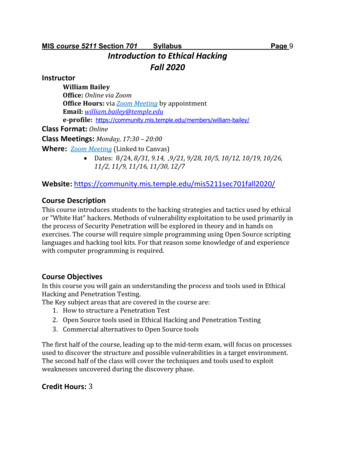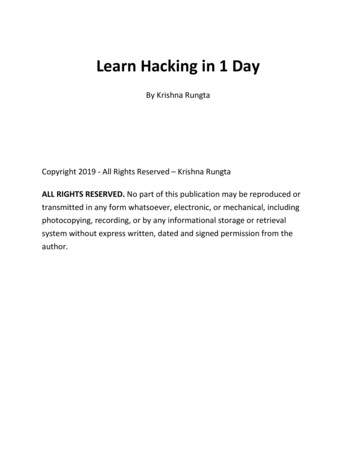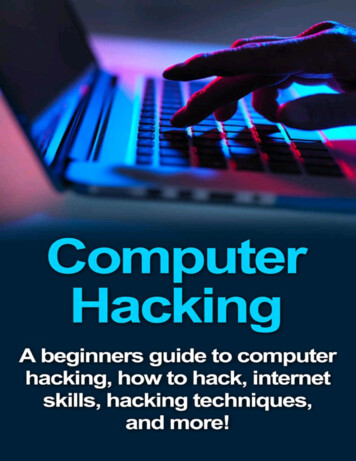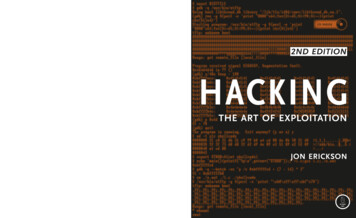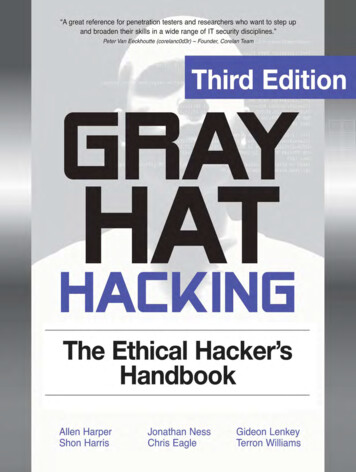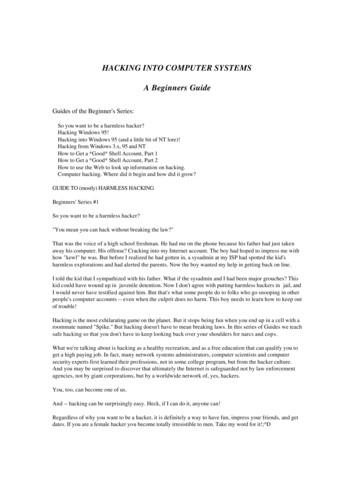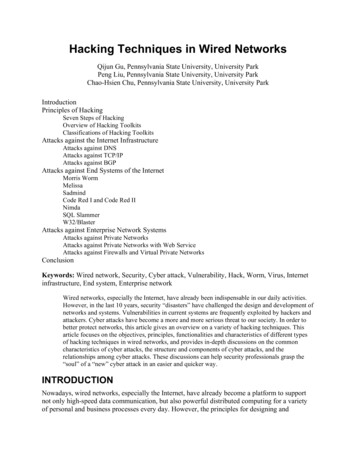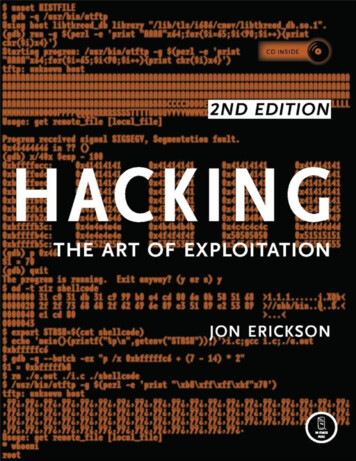
Transcription
Hacking: The Art of Exploitation,2nd EditionJon EricksonEditorWilliam PollockCopyright 2010
HACKING: THE ART OF EXPLOITATION, 2NDEDITION.Copyright 2008 by Jon Erickson.All rights reserved. No part of this work may be reproduced ortransmitted in any form or by any means, electronic ormechanical, including photocopying, recording, or by anyinformation storage or retrieval system, without the priorwritten permission of the copyright owner and the publisher.Printed on recycled paper in the United States of America11 10 09 08 07123456789ISBN-10: 1-59327-144-1ISBN-13: 978-1-59327-144-2Publisher:William PollockProduction Editors:Christina Samuell and Megan DunchakCover Design:Octopod StudiosDevelopmental Editor: Tyler OrtmanTechnical Reviewer:Aaron AdamsCopyeditors:Dmitry Kirsanov and Megan DunchakCompositors:Christina Samuell and Kathleen MishProofreader:Jim BrookIndexer:Nancy GuentherFor information on book distributors or translations, please
contact No Starch Press, Inc. directly:No Starch Press, Inc.555 De Haro Street, Suite 250, San Francisco, CA 94107phone: 415.863.9900; fax: 415.863.9950; info@nostarch.com;http://www.nostarch.comLibrary of Congress Cataloging-in-Publication DataErickson, Jon, 1977Hacking : the art of exploitation / Jon Erickson. -- 2nd ed.p. cm.ISBN-13: 978-1-59327-144-2ISBN-10: 1-59327-144-11. Computer security. 2. Computer hackers. 3. Computer networks-Security measures.I. Title.QA76.9.A25E75 2008005.8--dc222007042910No Starch Press and the No Starch Press logo are registeredtrademarks of No Starch Press, Inc. Other product andcompany names mentioned herein may be the trademarks oftheir respective owners. Rather than use a trademark symbolwith every occurrence of a trademarked name, we are usingthe names only in an editorial fashion and to the benefit of thetrademark owner, with no intention of infringement of thetrademark.The information in this book is distributed on an "As Is" basis,without warranty. While every precaution has been taken in thepreparation of this work, neither the author nor No StarchPress, Inc. shall have any liability to any person or entity withrespect to any loss or damage caused or alleged to be causeddirectly or indirectly by the information contained in it.
ACKNOWLEDGMENTSI would like to thank Bill Pollock and everyone else at NoStarch Press for making this book a possibility and allowing meto have so much creative control in the process. Also, I wouldlike to thank my friends Seth Benson and Aaron Adams forproofreading and editing, Jack Matheson for helping me withassembly, Dr. Seidel for keeping me interested in the science ofcomputer science, my parents for buying that first CommodoreVIC-20, and the hacker community for the innovation andcreativity that produced the techniques explained in this book.
PREFACEThe goal of this book is to share the art of hacking witheveryone. Understanding hacking techniques is often difficult,since it requires both breadth and depth of knowledge. Manyhacking texts seem esoteric and confusing because of just afew gaps in this prerequisite education. This second edition ofHacking: The Art of Exploitation makes the world of hacking moreaccessible by providing the complete picture—fromprogramming to machine code to exploitation. In addition, thisedition features a bootable LiveCD based on Ubuntu Linux thatcan be used in any computer with an x86 processor, withoutmodifying the computer's existing OS. This CD contains all thesource code in the book and provides a development andexploitation environment you can use to follow along with thebook's examples and experiment along the way.
Chapter 0x100. INTRODUCTIONThe idea of hacking may conjure stylized images of electronicvandalism, espionage, dyed hair, and body piercings. Mostpeople associate hacking with breaking the law and assumethat everyone who engages in hacking activities is a criminal.Granted, there are people out there who use hackingtechniques to break the law, but hacking isn't really about that.In fact, hacking is more about following the law than breakingit. The essence of hacking is finding unintended or overlookeduses for the laws and properties of a given situation and thenapplying them in new and inventive ways to solve a problem—whatever it may be.The following math problem illustrates the essence of hacking:Use each of the numbers 1, 3, 4, and 6 exactly once withany of the four basic math operations (addition,subtraction, multiplication, and division) to total 24. Eachnumber must be used once and only once, and you maydefine the order of operations; for example, 3 * (4 6) 1 31 is valid, however incorrect, since it doesn't total24.The rules for this problem are well defined and simple, yet theanswer eludes many. Like the solution to this problem (shownon the last page of this book), hacked solutions follow the rulesof the system, but they use those rules in counterintuitive ways.This gives hackers their edge, allowing them to solve problemsin ways unimaginable for those confined to conventionalthinking and methodologies.Since the infancy of computers, hackers have been creativelysolving problems. In the late 1950s, the MIT model railroadclub was given a donation of parts, mostly old telephoneequipment. The club's members used this equipment to rig up acomplex system that allowed multiple operators to controldifferent parts of the track by dialing in to the appropriate
sections. They called this new and inventive use of telephoneequipment hacking ; many people consider this group to be theoriginal hackers. The group moved on to programming onpunch cards and ticker tape for early computers like the IBM704 and the TX-0. While others were content with writingprograms that just solved problems, the early hackers wereobsessed with writing programs that solved problems well. Anew program that could achieve the same result as an existingone but used fewer punch cards was considered better, eventhough it did the same thing. The key difference was how theprogram achieved its results—elegance.Being able to reduce the number of punch cards needed for aprogram showed an artistic mastery over the computer. Anicely crafted table can hold a vase just as well as a milk cratecan, but one sure looks a lot better than the other. Earlyhackers proved that technical problems can have artisticsolutions, and they thereby transformed programming from amere engineering task into an art form.Like many other forms of art, hacking was oftenmisunderstood. The few who got it formed an informalsubculture that remained intensely focused on learning andmastering their art. They believed that information should befree and anything that stood in the way of that freedom shouldbe circumvented. Such obstructions included authority figures,the bureaucracy of college classes, and discrimination. In a seaof graduation-driven students, this unofficial group of hackersdefied conventional goals and instead pursued knowledgeitself. This drive to continually learn and explore transcendedeven the conventional boundaries drawn by discrimination,evident in the MIT model railroad club's acceptance of 12-yearold Peter Deutsch when he demonstrated his knowledge of theTX-0 and his desire to learn. Age, race, gender, appearance,academic degrees, and social status were not primary criteriafor judging another's worth—not because of a desire forequality, but because of a desire to advance the emerging artof hacking.
The original hackers found splendor and elegance in theconventionally dry sciences of math and electronics. They sawprogramming as a form of artistic expression and the computeras an instrument of that art. Their desire to dissect andunderstand wasn't intended to demystify artistic endeavors; itwas simply a way to achieve a greater appreciation of them.These knowledge-driven values would eventually be called theHacker Ethic: the appreciation of logic as an art form and thepromotion of the free flow of information, surmountingconventional boundaries and restrictions for the simple goal ofbetter understanding the world. This is not a new culturaltrend; the Pythagoreans in ancient Greece had a similar ethicand subculture, despite not owning computers. They sawbeauty in mathematics and discovered many core concepts ingeometry. That thirst for knowledge and its beneficialbyproducts would continue on through history, from thePythagoreans to Ada Lovelace to Alan Turing to the hackers ofthe MIT model railroad club. Modern hackers like RichardStallman and Steve Wozniak have continued the hackinglegacy, bringing us modern operating systems, programminglanguages, personal computers, and many other technologiesthat we use every day.How does one distinguish between the good hackers who bringus the wonders of technological advancement and the evilhackers who steal our credit card numbers? The term crackerwas coined to distinguish evil hackers from the good ones.Journalists were told that crackers were supposed to be thebad guys, while hackers were the good guys. Hackers stayedtrue to the Hacker Ethic, while crackers were only interested inbreaking the law and making a quick buck. Crackers wereconsidered to be much less talented than the elite hackers, asthey simply made use of hacker-written tools and scriptswithout understanding how they worked. Cracker was meant tobe the catch-all label for anyone doing anything unscrupulouswith a computer— pirating software, defacing websites, andworst of all, not understanding what they were doing. But veryfew people use this term today.
The term's lack of popularity might be due to its confusingetymology— cracker originally described those who cracksoftware copyrights and reverse engineer copy-protectionschemes. Its current unpopularity might simply result from itstwo ambiguous new definitions: a group of people who engagein illegal activity with computers or people who are relativelyunskilled hackers. Few technology journalists feel compelled touse terms that most of their readers are unfamiliar with. Incontrast, most people are aware of the mystery and skillassociated with the term hacker, so for a journalist, the decisionto use the term hacker is easy. Similarly, the term script kiddie issometimes used to refer to crackers, but it just doesn't have thesame zing as the shadowy hacker. There are some who will stillargue that there is a distinct line between hackers andcrackers, but I believe that anyone who has the hacker spirit isa hacker, despite any laws he or she may break.The current laws restricting cryptography and cryptographicresearch further blur the line between hackers and crackers. In2001, Professor Edward Felten and his research team fromPrinceton University were about to publish a paper thatdiscussed the weaknesses of various digital watermarkingschemes. This paper responded to a challenge issued by theSecure Digital Music Initiative (SDMI) in the SDMI PublicChallenge, which encouraged the public to attempt to breakthese watermarking schemes. Before Felten and his team couldpublish the paper, though, they were threatened by both theSDMI Foundation and the Recording Industry Association ofAmerica (RIAA). The Digital Millennium Copyright Act (DCMA)of 1998 makes it illegal to discuss or provide technology thatmight be used to bypass industry consumer controls. This samelaw was used against Dmitry Sklyarov, a Russian computerprogrammer and hacker. He had written software tocircumvent overly simplistic encryption in Adobe software andpresented his findings at a hacker convention in the UnitedStates. The FBI swooped in and arrested him, leading to alengthy legal battle. Under the law, the complexity of theindustry consumer controls doesn't matter—it would be
technically illegal to reverse engineer or even discuss Pig Latinif it were used as an industry consumer control. Who are thehackers and who are the crackers now? When laws seem tointerfere with free speech, do the good guys who speak theirminds suddenly become bad? I believe that the spirit of thehacker transcends governmental laws, as opposed to beingdefined by them.The sciences of nuclear physics and biochemistry can be usedto kill, yet they also provide us with significant scientificadvancement and modern medicine. There's nothing good orbad about knowledge itself; morality lies in the application ofknowledge. Even if we wanted to, we couldn't suppress theknowledge of how to convert matter into energy or stop thecontinued technological progress of society. In the same way,the hacker spirit can never be stopped, nor can it be easilycategorized or dissected. Hackers will constantly be pushingthe limits of knowledge and acceptable behavior, forcing us toexplore further and further.Part of this drive results in an ultimately beneficial co-evolutionof security through competition between attacking hackers anddefending hackers. Just as the speedy gazelle adapted frombeing chased by the cheetah, and the cheetah became evenfaster from chasing the gazelle, the competition betweenhackers provides computer users with better and strongersecurity, as well as more complex and sophisticated attacktechniques. The introduction and progression of intrusiondetection systems (IDSs) is a prime example of this coevolutionary process. The defending hackers create IDSs toadd to their arsenal, while the attacking hackers develop IDSevasion techniques, which are eventually compensated for inbigger and better IDS products. The net result of thisinteraction is positive, as it produces smarter people, improvedsecurity, more stable software, inventive problem-solvingtechniques, and even a new economy.The intent of this book is to teach you about the true spirit ofhacking. We will look at various hacker techniques, from the
past to the present, dissecting them to learn how and why theywork. Included with this book is a bootable LiveCD containingall the source code used herein as well as a preconfiguredLinux environment. Exploration and innovation are critical tothe art of hacking, so this CD will let you follow along andexperiment on your own. The only requirement is an x86processor, which is used by all Microsoft Windows machinesand the newer Macintosh computers—just insert the CD andreboot. This alternate Linux environment will not disturb yourexisting OS, so when you're done, just reboot again and removethe CD. This way, you will gain a hands-on understanding andappreciation for hacking that may inspire you to improve uponexisting techniques or even to invent new ones. Hopefully, thisbook will stimulate the curious hacker nature in you andprompt you to contribute to the art of hacking in some way,regardless of which side of the fence you choose to be on.
Chapter 0x200. PROGRAMMINGHacker is a term for both those who write code and those whoexploit it. Even though these two groups of hackers havedifferent end goals, both groups use similar problem-solvingtechniques. Since an understanding of programming helpsthose who exploit, and an understanding of exploitation helpsthose who program, many hackers do both. There areinteresting hacks found in both the techniques used to writeelegant code and the techniques used to exploit programs.Hacking is really just the act of finding a clever andcounterintuitive solution to a problem.The hacks found in program exploits usually use the rules ofthe computer to bypass security in ways never intended.Programming hacks are similar in that they also use the rulesof the computer in new and inventive ways, but the final goal isefficiency or smaller source code, not necessarily a securitycompromise. There are actually an infinite number of programsthat can be written to accomplish any given task, but most ofthese solutions are unnecessarily large, complex, and sloppy.The few solutions that remain are small, efficient, and neat.Programs that have these qualities are said to have elegance,and the clever and inventive solutions that tend to lead to thisefficiency are called hacks. Hackers on both sides ofprogramming appreciate both the beauty of elegant code andthe ingenuity of clever hacks.In the business world, more importance is placed on churningout functional code than on achieving clever hacks andelegance. Because of the tremendous exponential growth ofcomputational power and memory, spending an extra fivehours to create a slightly faster and more memory efficientpiece of code just doesn't make business sense when dealingwith modern computers that have gigahertz of processingcycles and gigabytes of memory. While time and memoryoptimizations go without notice by all but the most
sophisticated of users, a new feature is marketable. When thebottom line is money, spending time on clever hacks foroptimization just doesn't make sense.True appreciation of programming elegance is left for thehackers: computer hobbyists whose end goal isn't to make aprofit but to squeeze every possible bit of functionality out oftheir old Commodore 64s, exploit writers who need to writetiny and amazing pieces of code to slip through narrow securitycracks, and anyone else who appreciates the pursuit and thechallenge of finding the best possible solution. These are thepeople who get excited about programming and reallyappreciate the beauty of an elegant piece of code or theingenuity of a clever hack. Since an understanding ofprogramming is a prerequisite to understanding how programscan be exploited, programming is a natural starting point.What Is Programming?Programming is a very natural and intuitive concept. Aprogram is nothing more than a series of statements written ina specific language. Programs are everywhere, and even thetechnophobes of the world use programs every day. Drivingdirections, cooking recipes, football plays, and DNA are alltypes of programs. A typical program for driving directionsmight look something like this:Start out down Main Street headed east. Continue on Main Street untilyou seea church on your right. If the street is blocked because ofconstruction, turnright there at 15th Street, turn left on Pine Street, and then turnright on16th Street. Otherwise, you can just continue and make a right on16th Street.Continue on 16th Street, and turn left onto Destination Road. Drivestraightdown Destination Road for 5 miles, and then you'll see the house onthe right.The address is 743 Destination Road.Anyone who knows English can understand and follow these
driving directions, since they're written in English. Granted,they're not eloquent, but each instruction is clear and easy tounderstand, at least for someone who reads English.But a computer doesn't natively understand English; it onlyunderstands machine language. To instruct a computer to dosomething, the instructions must be written in its language.However, machine language is arcane and difficult to work with—itconsists of raw bits and bytes, and it differs from architectureto architecture. To write a program in machine language for anIntel x86 processor, you would have to figure out the valueassociated with each instruction, how each instructioninteracts, and myriad low-level details. Programming like this ispainstaking and cumbersome, and it is certainly not intuitive.What's needed to overcome the complication of writingmachine language is a translator. An assembler is one form ofmachine-language translator—it is a program that translatesassembly language into machine-readable code. Assembly languageis less cryptic than machine language, since it uses names forthe different instructions and variables, instead of just usingnumbers. However, assembly language is still far fromintuitive. The instruction names are very esoteric, and thelanguage is architecture specific. Just as machine language forIntel x86 processors is different from machine language forSparc processors, x86 assembly language is different fromSparc assembly language. Any program written using assemblylanguage for one processor's architecture will not work onanother processor's architecture. If a program is written in x86assembly language, it must be rewritten to run on Sparcarchitecture. In addition, in order to write an effective programin assembly language, you must still know many low-leveldetails of the processor architecture you are writing for.These problems can be mitigated by yet another form oftranslator called a compiler. A compiler converts a high-levellanguage into machine language. High-level languages aremuch more intuitive than assembly language and can beconverted into many different types of machine language for
different processor architectures. This means that if a programis written in a high level language, the program only needs tobe written once; the same piece of program code can becompiled into machine language for various specificarchitectures. C, C , and Fortran are all examples of highlevel languages. A program written in a high-level language ismuch more readable and English-like than assembly languageor machine language, but it still must follow very strict rulesabout how the instructions are worded, or the compiler won'tbe able to understand it.
Pseudo-codeProgrammers have yet another form of programming languagecalled pseudo-code. Pseudo-code is simply English arranged witha general structure similar to a high-level language. It isn'tunderstood by compilers, assemblers, or any computers, but itis a useful way for a programmer to arrange instructions.Pseudo-code isn't well defined; in fact, most people writepseudo-code slightly differently. It's sort of the nebulousmissing link between English and high-level programminglanguages like C. Pseudo-code makes for an excellentintroduction to common universal programming concepts.
Control StructuresWithout control structures, a program would just be a series ofinstructions executed in sequential order. This is fine for verysimple programs, but most programs, like the drivingdirections example, aren't that simple. The driving directionsincluded statements like, Continue on Main Street until you see a churchon your right and If the street is blocked because of construction . Thesestatements are known as control structures, and they change theflow of the program's execution from a simple sequential orderto a more complex and more useful flow.If-Then-ElseIn the case of our driving directions, Main Street could beunder construction. If it is, a special set of instructions needs toaddress that situation. Otherwise, the original set ofinstructions should be followed. These types of special casescan be accounted for in a program with one of the most naturalcontrolstructures: the if-then-else structure. In general, it lookssomething like this:If(condition) then{Set of instructions to execute if the condition is met;}Else{Set of instruction to execute if the condition is not met;}For this book, a C-like pseudo-code will be used, so everyinstruction will end with a semicolon, and the sets ofinstructions will be grouped with curly braces and indentation.The if-then-else pseudo-code structure of the preceding drivingdirections might look something like this:Drive down Main Street;If (street is blocked){
Turn right on 15th Street;Turn left on Pine Street;Turn right on 16th Street;}Else{Turn right on 16th Street;}Each instruction is on its own line, and the various sets ofconditional instructions are grouped between curly braces andindented for readability. In C and many other programminglanguages, the then keyword is implied and therefore left out,so it has also been omitted in the preceding pseudo-code.Of course, other languages require the then keyword in theirsyntax— BASIC, Fortran, and even Pascal, for example. Thesetypes of syntactical differences in programming languages areonly skin deep; the underlying structure is still the same. Oncea programmer understands the concepts these languages aretrying to convey, learning the various syntactical variations isfairly trivial. Since C will be used in the later sections, thepseudo code used in this book will follow a C-like syntax, butremember that pseudo-code can take on many forms.Another common rule of C-like syntax is when a set ofinstructions bounded by curly braces consists of just oneinstruction, the curly braces are optional. For the sake ofreadability, it's still a good idea to indent these instructions,but it's not syntactically necessary. The driving directions frombefore can be rewritten following this rule to produce anequivalent piece of pseudo-code:Drive down Main Street;If (street is blocked){Turn right on 15th Street;Turn left on Pine Street;Turn right on 16th Street;}ElseTurn right on 16th Street;This rule about sets of instructions holds true for all of the
control structures mentioned in this book, and the rule itselfcan be described in pseudo-code.If (there is only one instruction in a set of instructions)The use of curly braces to group the instructions is optional;Else{The use of curly braces is necessary;Since there must be a logical way to group these instructions;}Even the description of a syntax itself can be thought of as asimple program. There are variations of if-then-else, such asselect/case statements, but the logic is still basically the same:If this happens do these things, otherwise do these other things(which could consist of even more if-then statements).While/Until LoopsAnother elementary programming concept is the while controlstructure, which is a type of loop. A programmer will oftenwant to execute a set of instructions more than once. Aprogram can accomplish this task through looping, but itrequires a set of conditions that tells it when to stop looping,lest it continue into infinity. A while loop says to execute thefollowing set of instructions in a loop while a condition is true. Asimple program for a hungry mouse could look something likethis:While (you are hungry){Find some food;Eat the food;}The set of two instructions following the while statement willbe repeated while the mouse is still hungry. The amount of foodthe mouse finds each time could range from a tiny crumb to anentire loaf of bread. Similarly, the number of times the set ofinstructions in the while statement is executed changesdepending on how much food the mouse finds.
Another variation on the while loop is an until loop, a syntaxthat is available in the programming language Perl (C doesn'tuse this syntax). An until loop is simply a while loop with theconditional statement inverted. The same mouse program usingan until loop would be:Until (you are not hungry){Find some food;Eat the food;}Logically, any until-like statement can be converted into awhile loop. The driving directions from before contained thestatement Continue on Main Street until you see a church on your right.This can easily be changed into a standard while loop by simplyinverting the condition.While (there is not a church on the right)Drive down Main Street;For LoopsAnother looping control structure is the for loop. This isgenerally used when a programmer wants to loop for a certainnumber of iterations. The driving direction Drive straight downDestination Road for 5 miles could be converted to a for loop thatlooks something like this:For (5 iterations)Drive straight for 1 mile;In reality, a for loop is just a while loop with a counter. Thesame statement can be written as such:Set the counter to 0;While (the counter is less than 5){Drive straight for 1 mile;Add 1 to the counter;}The C-like pseudo-code syntax of a for loop makes this evenmore apparent:
For (i 0; i 5; i )Drive straight for 1 mile;In this case, the counter is called i, and the for statement isbroken up into three sections, separated by semicolons. Thefirst section declares the counter and sets it to its initial value,in this case 0. The second section is like a while statementusing the counter: While the counter meets this condition, keeplooping. The third and final section describes what actionshould be taken on the counter during each iteration. In thiscase, i is a shorthand way of saying, Add 1 to the counter called i.Using all of the control structures, the driving directions fromWhat Is Programming? can be converted into a C-like pseudocode that looks something like this:Begin going East on Main Street;While (there is not a church on the right)Drive down Main Street;If (street is blocked){Turn right on 15th Street;Turn left on Pine Street;Turn right on 16th Street;}ElseTurn right on 16th Street;Turn left on Destination Road;For (i 0; i 5; i )Drive straight for 1 mile;Stop at 743 Destination Road;
More Fundamental Programming ConceptsIn the following sections, more universal programmingconcepts will be introduced. These concepts are used in manyprogramming languages, with a few syntactical differences. AsI introduce these concepts, I will integrate them into pseudocode examples using C-like syntax. By the end, the pseudo codeshould look very similar to C code.VariablesThe counter used in the for loop is actually a type of variable. Avariable can simply be thought of as an object that holds datathat can be changed— hence the name. There are alsovariables that don't change, which are aptly called constants.Returning to the driving example, the speed of the car wouldbe a variable, while the color of the car would be a constant. Inpseudo code, variables are simple abstract concepts, but in C(and in many other languages), variables must be declared andgiven a type before they can be used. This is because a Cprogram will eventually be compiled into an executableprogram. Like a cooking recipe that lists all the requiredingredients before giving the instructions, variable declarationsallow you to make preparations before getting into the meat ofthe program. Ultimately, all variables are stored in memorysomewhere, and their declarations allow the compiler toorganize this memory more efficiently. In the end though,despite all of the variable type declara
hacking texts seem esoteric and confusing because of just a few gaps in this prerequisite education. This second edition of Hacking: The Art of Exploitation makes the world of hacking more accessible by providing the complete picture—from progr

